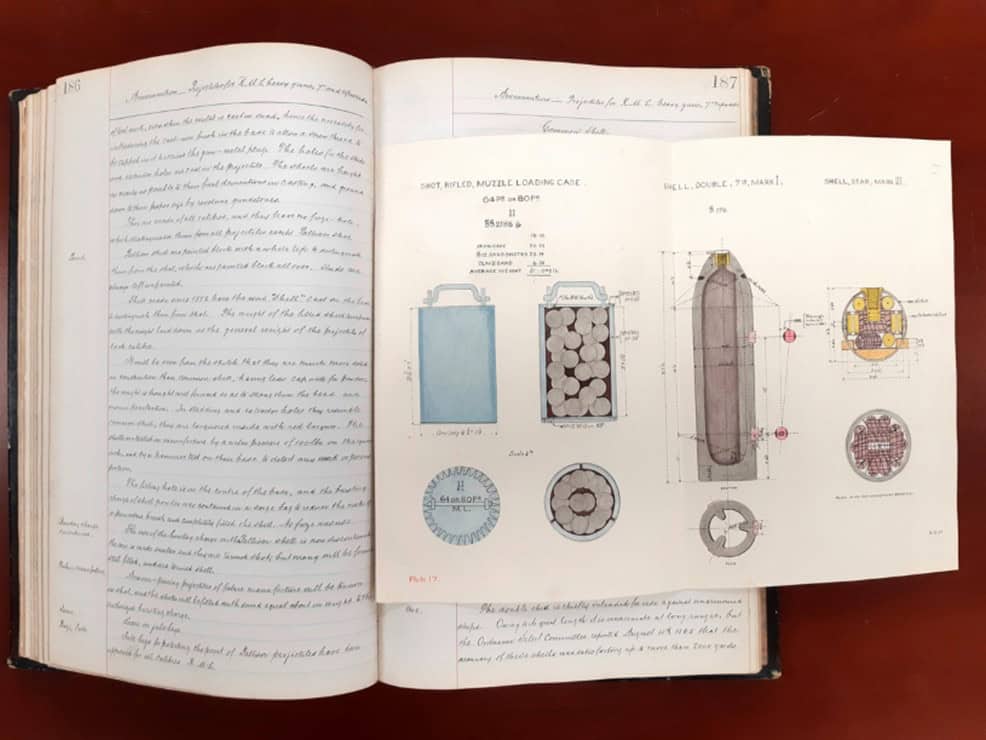Artillery Notes – A Donation From Colonel (Retired) Charles Simonds
The RCA Museum receives approximately thirty to fifty donations per year, some having unknown provenance. In some cases, an outside appraiser may review the artifact to determine its cultural significance, connection to the Canadian Artillery, and monetary value for a potential tax receipt. In 2014, the museum accepted an 1890s bound collection of Artillery Notes from past CFB Shilo Base Commander, Colonel (retired) Charles Simonds, but the provenance of the donation was ambiguous.
In 2021, after careful research, with the assistance of a rare book specialist, we determined that Quartermaster Thomas Maxwell from the Montreal Brigade of Garrison Artillery compiled the bound manuscript from unpublished and published sources from 1889 to 1892. The handwritten compilation contained 431 pages, including 143 blank pages and two pages of original introductory remarks. It includes 27 pages of guns, shells, fuzes, sights, and other artillery equipment, all masterfully drawn.

Quartermaster Thomas Maxwell from Montreal created this work to demonstrate the need for new guns and technology in the Garrison Artillery. The Montreal Brigade of Garrison Artillery had six batteries outfitted with obsolete rifled guns and smoothbore cannons during this timeframe. Maxwell said, “the Canadian Garrison Artillery is not receiving the attention its vast importance requires.” He intended to use the document to convince the military and the Canadian government to rearm the Canadian Artillery.
From 1875 to 1895, the Canadian Artillery, including Field Artillery and Garrison Artillery, was severely underfunded and suffered from a lack of uniform gun systems and technology. In 1876, for example, the Inspector of Artillery stated the Garrison Artillery was “in a demoralized condition,” suffering from antiquated equipment and poor working conditions. The Garrison Artillery used a variety of outdated rifled muzzleloaders and rifled breech-loading Armstrong guns, such as the 64 Pounder R.M.L. or the 20 Pounder R.B.L.
Maxwell emphasized the need for new rifled guns, particularly rifled howitzers, which did not exist in Canada in 1890. He said Gunners in garrison were mere “blue-coated infantry,” without rifled howitzers that would allow them to take up arms. He said the current state of artillery technology was a complicated and misunderstood topic, with the Garrison Artillery holding much of the collective knowledge.
After completion, what became of this one-of-a-kind document is unknown, and we don’t know if senior military leadership or federal government officials read it. However, in 1895, the Venezuela Boundary Dispute between Great Britain and the United States threatened a potential Anglo-American war, which pushed the Canadian government to rearm the Canadian militia. In 1897, some field batteries received 12 Pounder BLs, and some militia units received 5-Inch Howitzers and 4.7 Inch QF Guns. The new guns and funding advanced the Canadian Artillery with new technology, recruits, training and summer camps.
The bound collection of Artillery Notes compiled by Quartermaster Thomas Maxwell outlines the need for more funding and new rifled howitzers in the Garrison Artillery after a prolonged period of austerity from 1875 to 1895. It’s an important topic that deserves more attention, and we thank Charles Simonds for this generous donation and appreciate its historical significance to the RCA.
By Andrew Oakden
